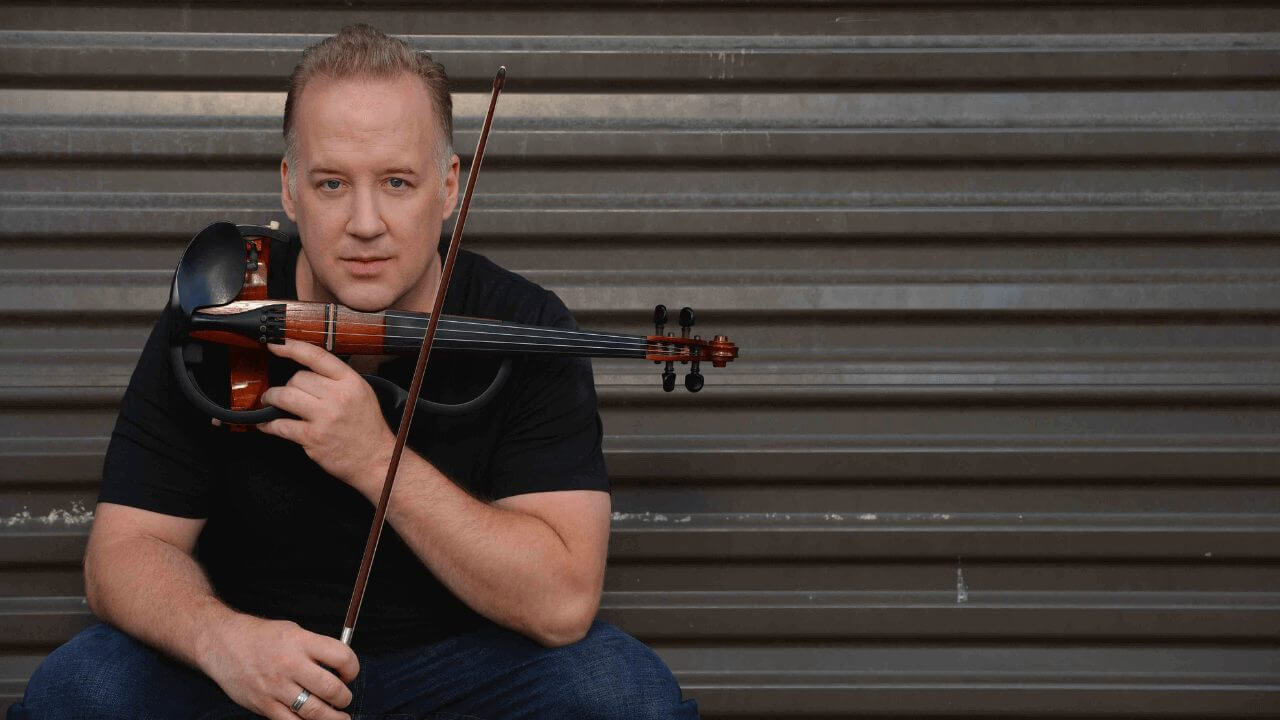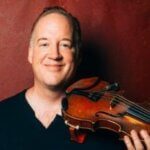This has been updated (2018) since it’s original posting.
If you are a string player heading to college who’s not banking solely on an orchestra job, and you want to develop a wide array of musical skills in order to work in multiple genres as a performer, composer, arranger, multi-instrumentalist, producer, or songwriter, it’s important to find a college that can accommodate you. As demand for this grows, undergraduate programs are slowly stepping up to fill the need, yet there are still only a small group of programs that have fully gotten the hint.
Table of Contents
Otherwise, barriers between departments, as well as rigid degree paths, may make it difficult for you to get the skills you need. Make sure faculty within all relevant disciplines (for example, the classical performance department and the jazz studies department) are all on board.
You also have online options now. The Newpark Music Centre in Dublin, Ireland recently asked me to work with a violin student to fulfill her undergraduate requirements for jazz violin through a mix of Skype lessons and my online curriculum at Creative Strings Academy. The summer Creative Strings Workshop can be a way to earn professional development/graduate credits.
Here is an alphabetical list of programs I’ve found- in some cases I’ve included feedback from faculty. Feel free to add info in the comments section below if you know about something that I’ve missed.
Best College Programs for Creative String Players (updated 2018)
Belmont University – Nashville, Tennessee
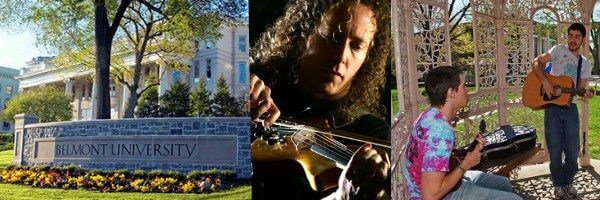
Tuition for 2018-2019: $34,310 / Housing: $12,120
Belmont, a Southern Baptist affiliated college, is situated right on music row in Nashville, which is where all the studios, producers, songwriters and players work, so many of the students are in bands, touring, recording, arranging and producing music long before they graduate. Students in Belmont’s string program study classical, commercial music or both (commercial music encompasses jazz, rock, celtic, bluegrass and more.)
Tracy Silverman, one of the violin teachers there, says “Don’t let the ‘commercial’ fool you – students in the commercial strings department are still required to take two years of conservatory-level classical training.”
Belmont has a few violin teachers, each with a genre speciality. Belmont is in the heart of Nashville, so you can be building a career in Nashville while still in school. I’ve heard from some students that the median playing level is not as advanced among the string players as Berklee, Manhattan School, or the New School. There may not be a lot of scholarship funds available directly through the music department, however, if you are academically gifted, you could try for scholarships.
Berklee College of Music – Boston, Massachusetts
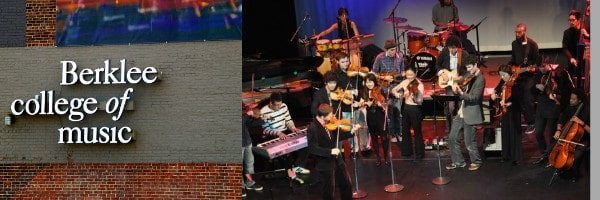
Tuition for 2018-2019: $42,880 / Housing: $13,850
I was an associate professor at Berklee College of Music for three years and I found it to be a wonderful environment. There are probably 200 string players within either the “strings” department or the new “American Roots” program, so you’re surrounded by people to play and share ideas with (which will ideally motivate you to practice). You’ll be able to explore everything from classical, jazz (early, swing and modern) to rock and fiddle styles (such as old time, celtic, bluegrass). As a testament to the diversity of music genres at Berklee, Matt Glaser, reports that students have been writing bluegrass/old-time inspired fiddle tunes over the changes of jazz standards – For example, check this audio clip out:
The ability of the students ranges from relative beginners to some of the best in the world. The cost of living in Boston is expensive and so is Berklee’s tuition. Some people go to Berklee with the goal of building a network, or just to see where they measure up against today’s prodigies. You can develop a lifelong network at Berklee with musicians who are going to move to New York or Los Angeles or Nashville and you can study things ranging from performance to composition, film scoring, and music business. Boston has become an international hub for fiddlers.
One big, positive change since my days teaching there – students can now study with teachers on other instruments. That said, there are many wonderful teachers in the strings department, including Darol Anger, Rob Thomas, Mimi Rabson, Matt Glaser, Eugene Friesen, Mike Block (cello), Joe Walsh (mandolin), Wes Corbett (banjo). Simon Shaheen (violin and oud), Jason Anick (violin), and Maeve Gilchrist (lever harp.). David Wallace is chair for the string department. He’s very approachable, organized, and he really cares.
Although Berklee is often regarded as a school for jazz, rock and modern music, they have several heavy hitting classical teachers. Like most colleges, the scholarship lottery is a bit hard to predict. Don’t expect to have your scholarship level raised the second year if you enter with a scholarship at one level. I have seen students lifted to incredible heights through Berklee’s program, and I have also seen some who suffered from the bureaucracy and financial strain.
All in all, Berklee is worth a strong look if you either have the money, are highly advanced, and/or you know for sure that a creative musical career is what you want to do. If you are sure that you want to go to Berklee, and if you are counting on a scholarship, begin networking with the faculty there. For that matter, make sure you have a YouTube channel and a social media network because, with Berklee’s for-profit business model, I suspect that they are more likely to take bets on students who are career-minded, with a foundation of promotional assets and a public profile. Students who are poised to promote their own careers can serve as future testaments to Berklee’s viability for other students.
For more on self-promotion for musicians, read my post here.
University of Colorado Boulder – Boulder, Colorado
Tuition for 2018/2019: $12,086 (in state) $36,220 (out of state) / Housing: $13,998
Connect with trumpet professor Brad Goode. He told me they are interested in serving string players interested in jazz. It’s a small program with a caring and attentive faculty.
Denison University – Granville, Ohio

Tuition for 2018-2019: $50,790 / Housing: $5,710
Denison’s program offers a music major in bluegrass. Denison has a reputation as a small liberal arts program. The overall playing level, as well as the amount of music students, is nowhere near The New School, Berklee, or many conservatories, but the students are enthusiastic and bright. An advantage of small liberal arts programs across the country is the possibility of receiving a lot of attention from music faculty in a small department. Regardless of a bluegrass major, I recommend considering small liberal arts programs in your state. Make sure to reach out to faculty in the music department with a clear statement of the things you want to work on, ask if they are receptive, and then set up a visit. When you do visit, try to meet with a few different teachers in the music department, and possibly have lessons with them.
The Manhattan School of Music – New York, New York
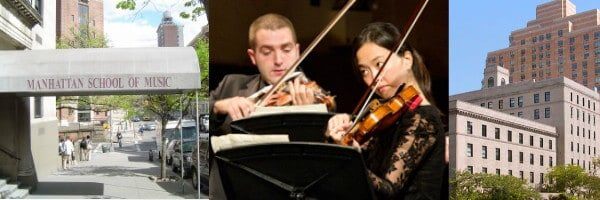
Tuition for 2018-2019: $46,700 / Housing: $10,480
The Manhattan School of Music has made efforts to provide private lessons for jazz violin players by hiring renowned violinist/teachers such as Sara Caswell. Jeremy Kittel finished his masters degree at Manhattan School and had a very good experience there. Manhattan School is highly competitive and highly expensive and I believe that they maybe somewhat rigid in terms of their requirements but if that’s fine with you, and you have the stomach and resources to live in Manhattan, then great.
Ben Sutin, an incredibly talented undergraduate violinist and alumni of Creative Strings Workshop, studied there and seems to be thriving in NYC. Luminary cellist/trombonist Dana Leong completed his undergraduate a MSM, although I believe he may have been forced to choose between trombone and cello. I have heard that Manhattan School of Music offers partnerships with Columbia and Barnard for double majors.
University of Miami, The Frost School of Music – Miami, Florida
Tuition for 2018-2019: $50,011 / Housing: $17,219
I’ve had the opportunity to present some clinics at the University of Miami’s Frost School of Music and I was delighted by what I saw. Many of the classically string players are interested in a variety of styles beyond classical music and the faculty is very supportive. Recently U of M implemented a change in their curriculum which requires all music majors to take an improvisation class. The jazz studies program there is excellent and so is the classical program.
What I’m most impressed by is the fact that there’s so much conversation happening between these two programs. The string program was influenced heavily by former professor Glenn Basham, Glenn is an improviser himself and a great classical violinist. Scott Flavin, also a violin professor, is a great arranger. Ross Harbaugh, the cello professor and head of the performance program is also really interested in many styles of music. Not only does the University of Miami seem to have resources, but they’re really making every effort in terms of curriculum. Many of the students I heard were very talented and multilingual in terms of classical and other styles. I’m assuming that they have decent scholarship opportunities available, and Miami is a cool city with lots of opportunity to work.
The University of Michigan – Ann Arbor, Michigan
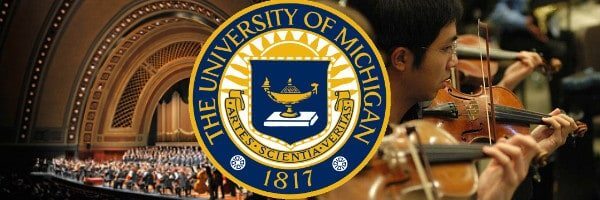
Tuition for 2018-2019 (out of state): $43,476 / Housing: $9,528
The University of Michigan has a long history of being friendly to string players. Not only does the school offer both a classical performance program and a jazz studies program (chaired by Ellen Rowe), but they also have a third stream music program where free improvisation is welcomed, along with other new musical forms. Jeremy Kittel and Brad Phillips, both highly acclaimed violinists went to University of Michigan and they were able to study with non-violinists including saxophone, piano and trombone professors. This is a great thing – string players too often think they need to study with other string players to learn jazz, but I’d rather see more students study with jazz experts on other instruments as well.
New England Conservatory – Boston, Massachusetts
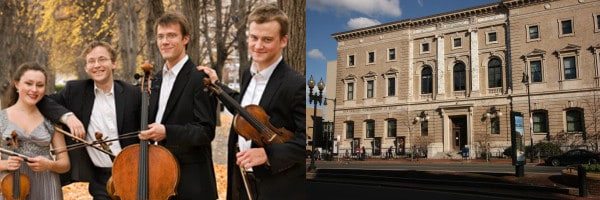
Tuition for 2018-2019: $46,930 / Housing: $15,700
Located adjacent to the Berklee campus, NEC has a smaller, more intimate program catering to classical, jazz, and the “contemporary improvisation” crowd. This means at NEC, you can learn more then just improvising in a typical jazz context – the contemporary improvisation department focuses on the improvisation musicians have been doing around the world. Tanya Kalmanovitch teaches viola here and she recently designed and is teaching a class titled “The Entrepreneurial Musician” – musical skill is only part of the equation for being a successful, working musician.
NEC has great faculty, and allows string players to study with any instrumentalist in private lessons. Because NEC is so small, my impression is that if you enter the contemporary improvisation program or the jazz program, you’ll have the flexibility to tailor your curriculum, which would be harder to do at a place like Berklee.
When I was looking for schools and summer programs for my child to consider (they’re into both classical and jazz and lots of other things too) I asked:
“Assuming that your (classical) performance, contemporary improv, and jazz programs are all top notch, how much flexibility would a classically trained (or non classically trained) string player have to rove between these departments? Can the student take classical violin lessons and, at the same time, study within the other programs with full support from all departments?”
I heard back:
“Hi Christian,… I am proud to say that, at New England Conservatory, the answer to your question is an emphatic ‘YES!’ The support for students who choose to develop their skills as versatile string players comes not only right from the top but also from our provost, string department head, and many individual teachers.
Our president, violist Tony Woodcock has written articles for the Huffington Post about the urgency of going beyond the traditional models of musical training, has sat in on and participated in many of our improvisation workshops, and even initiated an improvisation workshop at a combined meeting of NEC’s boards of trustees and overseers last year (we should have live-streamed that one – investment bankers singing ring-shouts and trading fours to a zydeco beat!). Our Provost Tom Novak, just returned from our annual residency in Panama (as participants in the Panama Jazz Festival) and, at faculty council, raved about the work one of our Contemporary Improvisation grad students (Abby Swidler) did in leading both classical string and improvisation workshops. Lucy Chapman, the head of our string department, has not only personally taught many of our best improvisational string players of all backgrounds, but initiated the formation of improvisation ensembles for NEC’s classical musicians so that they could become more versatile.
From my point of view as chair of Contemporary Improvisation, I consider it ESSENTIAL for all of our string players (along with all singers and instrumentalists) to learn technique that allows them to express the many voices one can express through an instrument. I am delighted to say that, over the years, our CI majors have studied with many of our top classical string faculty, including Lucy Chapman, Nicholas Kitchen, James Buswell, Natasha Brofsky, Larry Lesser, Martha Katz, Robert Brink, and the late Eric Rosenblith, Michelle AuClaire and Masuko Ushioda. I am also proud to have among our CI faculty string players who are true embodiments of the versatility we promote, Carla Kihlstedt, Eden MacAdam Somer, and Tanya Kalmanovitch, all of whom are universally respected as composer/performer/improvisers and all of whom have earned tremendous respect from our classical faculty.
Classical string players can choose to participate not only in our non-majors ensembles but also in classes such as Improvisation for Non-Majors, Intro to Jazz Improvisation and Ear-Training, and Advanced Aural Training and, once they have some grounding in learning music by ear and some stylistic flexibility, many of them participate in our jazz, improvisation, composition and world repertoire ensembles (including American Roots, African American Roots, Jewish Music, World Music, Middle Eastern Music, Choro, Persian Music, North Indian Music, and CI Chamber Ensemble, and they also take advanced jazz classes.
Our jazz department chair, Ken Schaphorst, regularly provides opportunities for string players to be part of our big band and has incorporated them into many special projects. Classical string players also occasionally petition to split their studios with our string improvisation faculty. We are delighted that, at NEC, there’s no question as to whether a string player can get a comprehensive musical education. I believe it’s a big attraction of the school.”
– Dr. Hankus Netsky Chair, Contemporary Improvisation New England Conservatory
The New School – Manhattan, New York
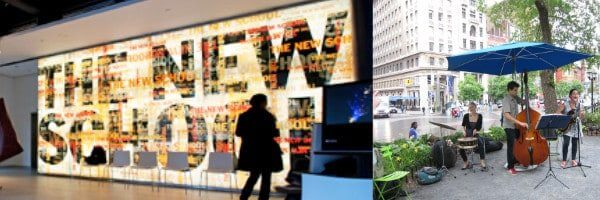
Tuition for 2018-2019: $23,480 / Housing: $19,200
The New School is technically two schools of music: Mannes College (which focuses on classical music) and the New School for Jazz and Contemporary Music (which, as its name would imply, focuses on jazz and modern music.) Either way, The New School is a great program for anyone who has the ability to live/survive in New York City – (financially as well as mentally). You have mostly top notch players in this small student body as well as a diverse and seasoned faculty to work with. You can also take private lessons with virtually anyone in the city.
I’ve had many string players who attended The New School studying with me as their private teacher even though I wasn’t full time at The New School. Many also study with Rob Thomas, who is full time in the Berklee college music and one of my personal favorite jazz violin or cello teachers. The New School is expensive and I’ve wondered at times what the program was like, but recently, I had the chance to speak with one of my former students, Peter Ugrin, who has since moved back to Slovenia after doing his certificate at The New School. He had glowing things to say about his experience, but stressed that it may be better for older undergraduates.
According to Ugrin, “The New School has money available if you play (at a high level) ; The bar is high, with some of the best young music students worldwide.” At The New School, you can study traditional music, jazz, modern, improvisation and anything in between. As a father, one concern I would have is whether a typical 18 yr-old freshman would be up to living alone in downtown Manhattan.
University of Northern Colorado – Greely, CO

Tuition for 2018-2019:
Undergrad: $8,166 in state / $19,752 out of state / Housing: $5,100
University of Northern Colorado hired Christopher Luther, an accomplished violist/violinist in jazz, bluegrass, pop and classical idioms, and he started an “alternative styles” ensemble/class. He’s since moved on. Said Chris in 2014: “The Alternative Styles program is new this year, and offered to all bowed strings. Right now I’m giving private lessons in alt styles and have an Alternative Styles Ensemble. For the private lessons, I let the students choose the path where they are most passionate. Some choose Celtic styes, some bluegrass, and some jazz. Whatever the style, it’s important that students understand harmony and rhythm so anyone can act as any instrument in a band. I then cover improv in each style.” Outside of this, University of Northern Colorado is a great overall music program – its jazz ensembles have earned over 90 Downbeat Student Awards and have performed at festivals all over the country.
University of Northern Texas
Tuition for 2018/2019: $10,544 (in state) $20,504 (out of state) / Housing: $6,500
UNT has a very highly-regarded Jazz program. Strings in the mix of Jazz have been historically off and on. Right now they are apparently “on”, given the recent hire of alternative styles strings faculty member–Scott Tixier
Oberlin College – Oberlin, Ohio

Tuition for 2018-2019: $54,346 / Housing: $8,108
Oberlin College is a historic university with a progressive and liberal arts traditions, as well as great classical and jazz departments. The jazz department has recently became open to getting involved with string players. (I do not know whether the classical performance program is equally receptive). Oberlin does not have a jazz violinist on faculty, so there is currently no way for a violinist to pursue a Jazz Performance Major at Oberlin. That said, you can still take jazz theory classes, improvisation classes and audition for jazz ensembles as a string player. In addition to jazz combos, Oberlin has the Performance and Improvisation (PI) ensemble, that has students transcribing and playing a variety of styles from the Caribbean, Africa, Middle East, South America and Asia. Oberlin also offers a degree option called “Musical Studies” let allows you combine studying music with another area in the arts and/or sciences.
My child Camille, is currently a student at Oberlin studying a double major in music (jazz) and creative writing. When they were applying for school, I wrote to friends in the faculty there and received this response:
“….as much as we promote cross fertilization of Jazz and Classical music at Oberlin, Oberlin has 2 major tracks, Classical and Jazz; and being admitted to Oberlin conservatory is done on the strength of the students mastery of the core of those musics….Being extremely talented and musical will not make up for demonstrating what Oberlin considers to be acceptable levels of instrument mastery and advanced core understanding of the established canon in either Jazz or Classical music.”
Peabody Conservatory of Music – Baltimore, Maryland
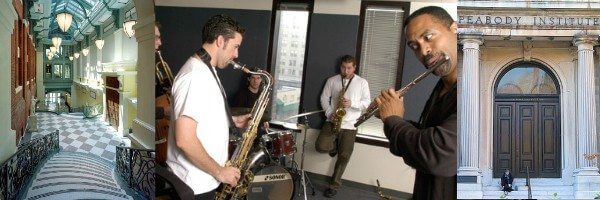
Tuition for 2018-2019: $48,645 / Housing: $4,590
Peabody only got their first jazz violin student a few years ago, however, they’ve recently done a bunch of new hires in the jazz department and the nature of their program makes me think they would be open and welcoming to having more improvising string players. Not only is the Peabody Conservatory a highly respected music program, it is part of the prestigious John Hopkins University. If you want to study music as well a science-leaning non-music field (such as engineering, medicine, etc), this is a place you should check out. Doing a double major can challenging, not only do you have split your homework time between two majors, but you also have to deal with ensemble rehearsals scheduled at the same time as bio labs, etc. That said, if you’re dedicated, it is certainly possible and can be very rewarding. Peabody faculty and advisors are very supportive of double majors and will do what they can to make sure you are getting the experience you want (they have an entire page breaking down double majors here.)
University of Southern California – Los Angeles, California

Tuition for 2018-2019: $55,320 / Housing: $16,390
University of Southern California’s Thornton School of Music, like many other universities, is in the process of becoming friendly to improvising string players. One way they’ve done this is by hiring Robert Anderson as a jazz violin teacher. Last I checked they didn’t have a huge body of string students studying jazz but Rob is a great teacher, so this is a great first step. That said, I’ve also heard that USC’s classical and jazz departments are among the best in the nation.
Utah Valley University
Tuition: $5,777 (in state) $16,451 (out of state) / No on-campus housing offered
Utah Valley University has a growing music department with a brand-new facility coming in 2019. Dr. Donna Fairbanks, violin professor and music department chair is encouraging to jazz/alternative string players and has brought me in for a workshop a few years ago. Alex Heitlinger is the director of the jazz department and says he’d love to see more string players in the program. While there is no official jazz/alternative styles faculty for bowed strings, the environment is encouraging, friendly and offers resources to advance in jazz studies. This may be an option for students looking to continue their study in jazz and alternative styles but not on an intense conservatory level as of yet.
Vandercook College of Music – Chicago, Illinois
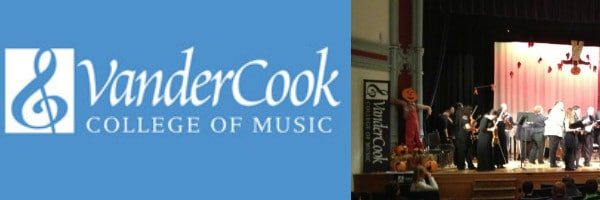
Undergrad Tuition for 2017-2018: $26,458 / Housing: $12,255
String teachers looking to expand their knowledge through continuing education credits should look at Vandercook College of Music. A private liberal arts school located in Chicago, they are the only school in the country devoted solely to teaching music educators. Location is only a minor detail however, as they offer online courses in many topics relevant to today’s music teacher, including GarageBand in the Classroom, Integrating the iPad in Music Education, Creating and Editing Digital Recordings.
Schools Abroad
European cities and countries such as Barcelona, Paris, Holland, Germany and Austria all have schools that offer the opportunity to study jazz violin. I have visited these (below) as a clinician and been impressed with the musicianship. In general, I find the European attitude to be completely different, and I definitely encourage Americans to consider going abroad to not only “catch the vibe” but also to enjoy a distinct competitive advantage in terms of getting gigs. After all, in Europe or Asia you’ll be seen as “exotic”, at least for a while:) If you are serious about going to school in Europe, bear in mind the application process is quite different than for American schools. Give yourself plenty of time to navigate web-pages that don’t always translate perfectly in English.
The Escola Superior de Música de Catalunya – Barcelona, Spain

“Rather than just teach its students how to play music, The Escola Superior de Música de Catalunya (ESMUC), seeks to teach music as both a profession and a social phenomenon. This isn’t to say playing music is secondary” –
ArtEZ Institute of the Arts – Various cities, Netherlands
 The ArtEZ Institute of the Arts has three different campuses throughout the Netherlands, located in Arnhem, Enschede and Zwolle. Music is just one of the many artistic areas of study ArtEZ offers: they also have programs in fine art, design, fashion, creative writing, dance, theatre, architecture and art education. The school of music alone has over 900 students (although remember this is spread out over three different campuses). Besides classical and jazz studies, ArtEZ has an Academy of Pop Music.
The ArtEZ Institute of the Arts has three different campuses throughout the Netherlands, located in Arnhem, Enschede and Zwolle. Music is just one of the many artistic areas of study ArtEZ offers: they also have programs in fine art, design, fashion, creative writing, dance, theatre, architecture and art education. The school of music alone has over 900 students (although remember this is spread out over three different campuses). Besides classical and jazz studies, ArtEZ has an Academy of Pop Music.
The Academy of Music and Dance Cologne – Various Cities, Germany

Like the ArtEZ, The Academy of Music and Dance Cologne actually has schools in three cities: Cologne, Wuppertal and Aachen. The Academy is slightly more traditional then ArtEZ, but they still pride themselves on being forward thinking and offering a diverse, well rounded music education. Folk musicians take note, the Wuppertal location offers classes with the only professor of mandolin in Europe.
Didier Lockwood Music Center (also known as CMDL) – Paris, France
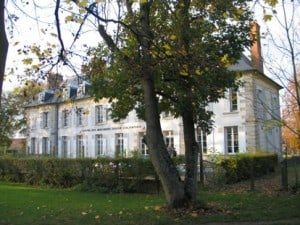 Smaller then the other three international schools listed, Didier Lockwood Music Center offers a a Bachelor in Music and Performing Arts, focused on jazz and improvising music. At the CMDL, you’ll learn a wide variety of topics within the music field, including improvisation, harmony, song writing and orchestration, ear training, rhythm training, musical background knowledge, music on and with computers, ensemble practicing, initiation to piano for non-pianists and more.
Smaller then the other three international schools listed, Didier Lockwood Music Center offers a a Bachelor in Music and Performing Arts, focused on jazz and improvising music. At the CMDL, you’ll learn a wide variety of topics within the music field, including improvisation, harmony, song writing and orchestration, ear training, rhythm training, musical background knowledge, music on and with computers, ensemble practicing, initiation to piano for non-pianists and more.
Corinthian State Conservatory of Music (KONSE) – Klagenfurt, Austria
 Jazz violinist Max Grosch teaches at the Corinthian State Conservatory of Music, which typically has around 900 music students and is a part of Alpen-Aldria University of Klagenfurt. It’s worth noting that to do a semester studying abroad at KONSE, American students are encouraged, but not required, to know German. Although Austria have a rich legacy of classical music, Grosch is no genre purist – his recent albums included an organ-violin-drums trio, as well as a collection of Brahms music arranged for jazz quartet. I can vouch that Max is a great player and his students all rave about him as a teacher as well.
Jazz violinist Max Grosch teaches at the Corinthian State Conservatory of Music, which typically has around 900 music students and is a part of Alpen-Aldria University of Klagenfurt. It’s worth noting that to do a semester studying abroad at KONSE, American students are encouraged, but not required, to know German. Although Austria have a rich legacy of classical music, Grosch is no genre purist – his recent albums included an organ-violin-drums trio, as well as a collection of Brahms music arranged for jazz quartet. I can vouch that Max is a great player and his students all rave about him as a teacher as well.
Alternative Strings Vienna – Vienna, Austria
 For all non-German speakers, this video gives a great overview of this program. It’s a small program and is designed specifically for violinists, violists and cellists studying jazz and popular music. They have a practice facility with a library of Jamey Aeborsold play-a-longs, but don’t expect to spend much time playing and interacting with a full, live rhythm section (Mic Oeschsner, the director of this program, notes that the main time you play with a live rhythm section is the annual all strings big band concert.) That said, if you’re looking for some time to learn and shed without the distraction of playing outside gigs, etc, this might be a good place for you. Since Alternative Strings Vienna is solely an institute for music, I’m not sure how a diploma from here transfers to the U.S., but then again, that might not matter to you, depending on what you’re looking to get out of this program.
For all non-German speakers, this video gives a great overview of this program. It’s a small program and is designed specifically for violinists, violists and cellists studying jazz and popular music. They have a practice facility with a library of Jamey Aeborsold play-a-longs, but don’t expect to spend much time playing and interacting with a full, live rhythm section (Mic Oeschsner, the director of this program, notes that the main time you play with a live rhythm section is the annual all strings big band concert.) That said, if you’re looking for some time to learn and shed without the distraction of playing outside gigs, etc, this might be a good place for you. Since Alternative Strings Vienna is solely an institute for music, I’m not sure how a diploma from here transfers to the U.S., but then again, that might not matter to you, depending on what you’re looking to get out of this program.
As far as programs in Asia, Canada, and elsewhere around the world, I’ll be the first to let you know as I learn more.
Admittedly, there are other programs in the U.S. offering more than just a traditional performance degree for undergraduate string players. Off the top of my head, Cincinnati Conservatory, Ball State, Indiana University, North Texas, and Ohio State come to mind as programs which are potentially “friendly” to creative string players, if you know who to speak with (for example, it could be someone in the Jazz dept or someone in strings, depending).
Feel free to leave a comment below, optin for my updates on this page, share this with friends, and check out my other resources for Creative String Players including online curriculum, residencies in schools, and the summer Creative Strings Workshop and Festival held every July in Columbus, Ohio. If you’re on Facebook, join the group “Creative String Players”.
